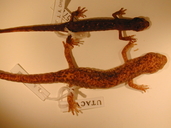|
Pseudoeurycea aquatica Wake & Campbell, 2001
| family: Plethodontidae subfamily: Hemidactyliinae genus: Pseudoeurycea |
 © 2020 David Wake (1 of 3) |
|
|
|
Description Dorsal coloring is reddish brown with distinct mottling that is heavily dark brown. Upper eyelids are lighter in color and sparsely spotted. Slight color intensity variations exist. Females are darkly colored compared to males (Wake and Campbell 2001). Distribution and Habitat Country distribution from AmphibiaWeb's database: Mexico
Life History, Abundance, Activity, and Special Behaviors Trends and Threats Possible reasons for amphibian decline Habitat modification from deforestation, or logging related activities Comments
References
Wake, D. B. and Campbell, J. A. (2001). ''An aquatic Plethodontid salamander from Oaxaca, Mexico.'' Herpetologica, 57(4), 509-514. Originally submitted by: Michelle Iwaki (first posted 2004-02-18) Edited by: TateTunstall (2004-03-02) Species Account Citation: AmphibiaWeb 2004 Pseudoeurycea aquatica <https://amphibiaweb.org/species/5916> University of California, Berkeley, CA, USA. Accessed Mar 29, 2025.
Feedback or comments about this page.
Citation: AmphibiaWeb. 2025. <https://amphibiaweb.org> University of California, Berkeley, CA, USA. Accessed 29 Mar 2025. AmphibiaWeb's policy on data use. |



 Raffaëlli Account
Raffaëlli Account Map of Life
Map of Life